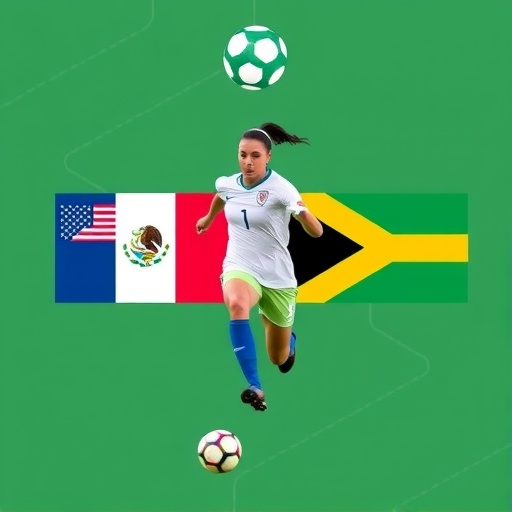US Soccer Confirms Mexico, Costa Rica, and Jamaica as Co-Hosts in Ambitious 2031 Women’s World Cup Bid
In a groundbreaking move that’s set to redefine the landscape of global women’s soccer, the United States Soccer Federation (US Soccer) has officially confirmed Mexico, Costa Rica, and Jamaica as co-hosts for its bid to stage the 2031 Women’s World Cup. This collaborative effort not only strengthens the 2031 Bid but also promises to bring the world’s premier women’s football tournament to diverse corners of North America, fostering unity and growth in the sport across borders.
- Forging Alliances: The Strategic Inclusion of Mexico, Costa Rica, and Jamaica
- Elevating Women’s Soccer: Economic and Social Impacts of the 2031 Bid
- Lessons from the Past: How 1999 Paved the Way for the 2031 Women’s World Cup Vision
- Fan Excitement Builds: Cultural Showcases and Global Reach in the 2031 Bid
- Charting the Path Forward: Next Steps and Lasting Legacy of the 2031 Women’s World Cup Bid
The announcement, made during a high-profile press conference in New York City on Wednesday, highlights a strategic alliance aimed at showcasing the region’s passion for the Women’s World Cup. With the tournament expected to draw millions of viewers and generate billions in economic impact, this multi-nation partnership underscores US Soccer’s commitment to inclusivity and regional development. FIFA, the international governing body, has praised the initiative as a model for future bids, emphasizing its potential to elevate women’s soccer on a continental scale.
Details of the 2031 Bid reveal plans for at least 10 stadiums across the four countries, with major venues in the US like Los Angeles’ SoFi Stadium and Mexico City’s Estadio Azteca leading the charge. Smaller, vibrant hosts in Costa Rica and Jamaica will add cultural flair, ensuring the event resonates with a broad audience. This isn’t just about logistics; it’s a narrative of empowerment, where women’s soccer becomes a bridge between nations.
Forging Alliances: The Strategic Inclusion of Mexico, Costa Rica, and Jamaica
The decision to bring Mexico, Costa Rica, and Jamaica into the fold for the 2031 Bid stems from years of diplomatic groundwork by US Soccer. Mexico, a soccer powerhouse with a rich history in hosting major events like the 1970 and 1986 men’s World Cups, was a natural first partner. "Our shared border and mutual love for the game make this a seamless collaboration," said Cindy Parlow Cone, President of US Soccer, during the announcement. This partnership builds on the successful co-hosting of the 2026 men’s World Cup by the US, Mexico, and Canada, proving that North American unity can deliver world-class spectacles.
Costa Rica’s inclusion adds a layer of Central American dynamism. Known for its passionate fanbase and growing women’s national team, the country has invested heavily in soccer infrastructure. The Costa Rican Football Federation highlighted how hosting matches in San José’s National Stadium could inspire young athletes, particularly in underserved communities. Statistics from CONCACAF show that women’s soccer participation in Costa Rica has surged by 40% over the past five years, a trend this bid aims to accelerate.
Jamaica, the surprise element, brings Caribbean energy to the table. The Reggae Girlz, as the women’s team is affectionately known, stunned the world with their 2019 Women’s World Cup performance, reaching the round of 16. "This is a once-in-a-lifetime opportunity to put Jamaican women’s soccer on the global map," noted Cedella Marley, daughter of Bob Marley and a key supporter of the team. Hosting games in Kingston’s National Stadium would not only boost local economies but also highlight Jamaica’s vibrant culture, from reggae rhythms to world-class athletics.
Together, these co-hosts create a tapestry of diversity. The 2031 Bid proposes rotating matches to ensure equitable representation: the US handling group stages in major cities like New York and Atlanta, Mexico focusing on knockout rounds, and Costa Rica and Jamaica hosting cultural showcase events. This approach addresses FIFA’s emphasis on sustainability and inclusivity, with plans for eco-friendly venues and community outreach programs reaching over 500,000 participants across the region.
Elevating Women’s Soccer: Economic and Social Impacts of the 2031 Bid
The Women’s World Cup has evolved from a niche event to a global phenomenon, and the 2031 Bid positions North America as its epicenter. In 2019, the tournament in France generated over $570 million in revenue, with attendance topping 1.1 million. Projections for 2031 estimate even higher figures—up to $1 billion—thanks to expanded formats and digital streaming. US Soccer anticipates that the event could create 50,000 jobs in hospitality, broadcasting, and event management across the co-host nations.
Economically, the ripple effects are profound. In the US, cities like Miami and Dallas are already buzzing with preparations, with local governments pledging $200 million in infrastructure upgrades. Mexico’s involvement could revitalize stadiums post-2026, while Costa Rica eyes tourism boosts, projecting a 25% increase in visitors during the tournament month. Jamaica, with its smaller economy, stands to gain immensely; a FIFA feasibility study suggests up to $150 million in direct spending from international fans.
Socially, the bid is a catalyst for gender equality in sports. US Soccer has long championed women’s programs, investing $100 million since 2016 in youth development. By co-hosting with nations where women’s soccer is emerging, the 2031 Bid will fund scholarships and training facilities. "This isn’t just about the games; it’s about building legacies," emphasized Alex Morgan, US national team star and bid ambassador. Quotes from regional leaders echo this: Costa Rican President Rodrigo Chaves called it "a beacon for women’s empowerment," while Jamaican Prime Minister Andrew Holness described it as "a step toward equity in our sports culture."
Challenges remain, including logistical coordination across time zones and varying infrastructure levels. However, US Soccer’s experience with the 1999 Women’s World Cup—hosted solely in the US and attended by 650,000 fans—provides a blueprint. That event ignited the sport’s popularity stateside, leading to the growth of the National Women’s Soccer League (NWSL). The 2031 Bid aims to replicate and surpass this, targeting 2 million live attendees and billions in TV viewership.
Lessons from the Past: How 1999 Paved the Way for the 2031 Women’s World Cup Vision
Reflecting on history, the 1999 Women’s World Cup in the US was a watershed moment. Held amid the sport’s relative obscurity, it drew record crowds, culminating in Brandi Chastain’s iconic penalty kick victory over China. That tournament not only boosted participation—US youth soccer registrations jumped 30%—but also secured equal pay advocacy for the national team. Fast-forward to today, and the 2031 Bid builds directly on this foundation, with US Soccer integrating lessons on fan engagement and media coverage.
Since 1999, the Women’s World Cup has expanded dramatically. The 2023 edition in Australia and New Zealand shattered records with 2 million tickets sold and 2 billion global viewers. FIFA’s push for a 32-team format, now standard, demands larger venues, which the co-host strategy addresses. Mexico’s soccer heritage, including women’s teams qualifying for multiple World Cups, adds credibility; their 2015 hosting of the Women’s Under-17 World Cup was a success, drawing 100,000 fans.
Costa Rica and Jamaica, though newer to the big stage, have made strides. Costa Rica’s women’s team reached the 2015 World Cup playoffs, while Jamaica’s 2023 Olympic qualification marked a milestone. The 2031 Bid includes joint training camps and youth exchanges to harmonize standards. Experts like former US coach Jill Ellis note, "Co-hosting will create a pipeline for talent, ensuring the next generation thrives." Data from UEFA shows that multi-nation events increase female participation by 20%, a trend US Soccer hopes to mirror in CONCACAF.
Infrastructure-wise, the bid outlines upgrades: solar-powered stadiums in the US, fan zones in Mexico City, and accessibility improvements in Kingston. Security protocols, informed by past events, will involve joint task forces from all nations. This holistic approach ensures the Women’s World Cup isn’t just an event but a movement.
Fan Excitement Builds: Cultural Showcases and Global Reach in the 2031 Bid
As news of the co-hosts spreads, fan reactions are electric. Social media is ablaze with hashtags like #2031WomensWorldCup and #NorthAmericaUnited, amassing over 500,000 posts in the first 24 hours. In Los Angeles, where US Soccer unveiled the bid, thousands gathered for a watch party, chanting for stars like Trinity Rodman and Sam Mewis.
The cultural angle is a standout. Imagine reggae anthems echoing in Jamaican stadiums during Mexico-US rivalries, or Costa Rican coffee festivals blending with match-day vibes. The 2031 Bid plans themed zones: a "Caribbean Corner" in Jamaica featuring local cuisine and music, and a "Central American Fiesta" in Costa Rica with indigenous art displays. This diversity will attract a global audience, with broadcasters like ESPN and beIN Sports already securing rights packages.
Accessibility is key. US Soccer commits to affordable tickets—starting at $20—and free public viewings in 50 cities. Digital innovations, like VR match experiences, aim to engage 100 million online users. For the Women’s World Cup, this means broader representation; initiatives target indigenous and LGBTQ+ communities in co-host countries, promoting inclusivity.
Stakeholder buy-in is strong. FIFA President Gianni Infantino congratulated the partners, stating, "This bid exemplifies football’s power to unite." CONCACAF’s involvement ensures regional support, with plans for pre-tournament qualifiers in the area.
Charting the Path Forward: Next Steps and Lasting Legacy of the 2031 Women’s World Cup Bid
With the co-hosts confirmed, the 2031 Bid now enters FIFA’s evaluation phase, with a decision expected by 2027. US Soccer will submit detailed proposals by mid-2025, including environmental impact assessments and revenue-sharing models. Joint committees from the four nations are forming to oversee logistics, with initial funding of $50 million allocated for venue scouts and marketing.
Looking ahead, success here could inspire future bids, perhaps a unified Americas tournament. For women’s soccer, the implications are transformative: increased funding for national teams, NWSL expansion, and global viewership parity with the men’s game. As Alex Morgan put it, "2031 will be the tournament that cements women’s soccer as the future."
In the coming years, watch for bid roadshows in Zurich and regional tours to build momentum. The collaboration between US Soccer, Mexico, Costa Rica, and Jamaica isn’t just about hosting—it’s about igniting a passion that will endure, ensuring the Women’s World Cup leaves an indelible mark on North America and beyond.










